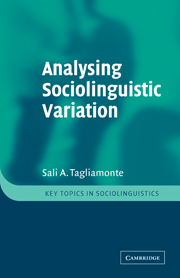Book contents
- Frontmatter
- Contents
- Preface
- Notes on codes and abbreviations
- 1 Introduction
- 2 Data collection
- 3 The sociolinguistic interview
- 4 Data, data and more data
- 5 The linguistic variable
- 6 Formulating hypotheses/operationalising claims
- 7 The variable rule program: theory and practice
- 8 The how-to's of a variationist analysis
- 9 Distributional analysis
- 10 Multivariate analysis
- 11 Interpreting your results
- 12 Finding the story
- Glossary of terms
- References
- Index
7 - The variable rule program: theory and practice
Published online by Cambridge University Press: 05 June 2012
- Frontmatter
- Contents
- Preface
- Notes on codes and abbreviations
- 1 Introduction
- 2 Data collection
- 3 The sociolinguistic interview
- 4 Data, data and more data
- 5 The linguistic variable
- 6 Formulating hypotheses/operationalising claims
- 7 The variable rule program: theory and practice
- 8 The how-to's of a variationist analysis
- 9 Distributional analysis
- 10 Multivariate analysis
- 11 Interpreting your results
- 12 Finding the story
- Glossary of terms
- References
- Index
Summary
Why variable rule analysis?
This chapter will introduce the statistical analysis of variable rules. It will cover the terms ‘input’,' log likelihood' and ‘significance’, and describe what they mean.
The fact that grammatical structures incorporate choice as a basic building block means that they accept probabilization in a very natural way, mathematically speaking.
(Sankoff 1978: 235)This chapter is written in two parts. The first part is theoretical, designed to tell you about the variable rule program, variable rules and their history. Importantly, I address the issues of why to use the variable rule program at all. The second part is practical, providing you with an overview of how the fundamental characteristics of the variable rule program function in the Goldvarb series of programs.
First, here is where you can download the variable rule program (Rand and Sankoff 1990, Robinson et al. 2001, Sankoff et al. 2005): http://www.crm.umontreal.ca/~sankoff/GoldVarb_Eng.html; http://www.york.ac.uk/depts/lang/webstuff/goldvarb/; http://individual. utoronto.ca/tagliamonte/Goldvarb/GV_index.htm (Goldvarb 2.1, Goldvarb 2001, Goldvarb X).
THEORY
Much of what is mysterious about variationist sociolinguistics comes from the often arcane technical descriptions of its primary analytic tool, the variable rule program. Like many things that involve numbers, reading about the variable rule program often incites a negative response. However, the variable rule program is an incredible tool, not only for conducting sophisticated statistical analyses, but also for helping you to make sense of linguistic data, and even for simply organising it.
- Type
- Chapter
- Information
- Analysing Sociolinguistic Variation , pp. 128 - 157Publisher: Cambridge University PressPrint publication year: 2006

